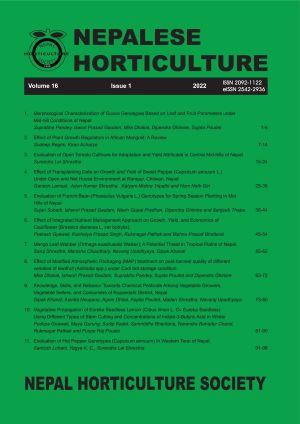Effect of Plant Growth Regulators in African Marigold: A Review
DOI:
https://doi.org/10.3126/nh.v16i1.45005Keywords:
Garlands, phyto-hormone, plant growth regulators, Tagetes, yieldAbstract
African marigold, being tall enough and producing large flowers suitable for preparing garlands, is the most cultivated cultivar of marigold in Nepal. Besides, pinching and other improved cultural techniques, a number of chemicals, hormones and phyto-hormones are being tested and found to impart a varying response in African marigold. This review has its importance for standardizing the type and concentration of plant growth regulators in African marigold. Online journals, scientific papers, proceedings, books, thesis and lecture notes are the key reference site for this review. Gibberellins or gibberellic acids (GA3), ethrel, paclobutrazol, salicylic acid, Indole 3 Acetic Acid, Naphthalene Acetic Acid (NAA), Chlormequat Chloride and sea weed extract are the most widely used and proven biochemical with pronounced effect on growth, development and differentiation in marigold. Among these, 300 ppm, 350 ppm and 450 ppm of GA3 results higher plant height, minimum days for flower initiation and higher basal diameter respectively. Similarly, 450 ppm for higher number of branches and leaves per plant and 400 ppm of GA3 or 600 ppm of CCC has been found to impart higher number and weight of flowers per plants. Besides, 1000 ppm of CCC has been found more effective to impart higher productivity (yield/ ha) in African marigold. Hence, plant growth regulators have been a valuable agent for optimizing yield and yield potential in African marigold.
Downloads
Downloads
Published
How to Cite
Issue
Section
License
Copyright (c) 2022 Nepalese Horticultural Society

This work is licensed under a Creative Commons Attribution-NonCommercial 4.0 International License.
© Nepalese Horticultural Society

